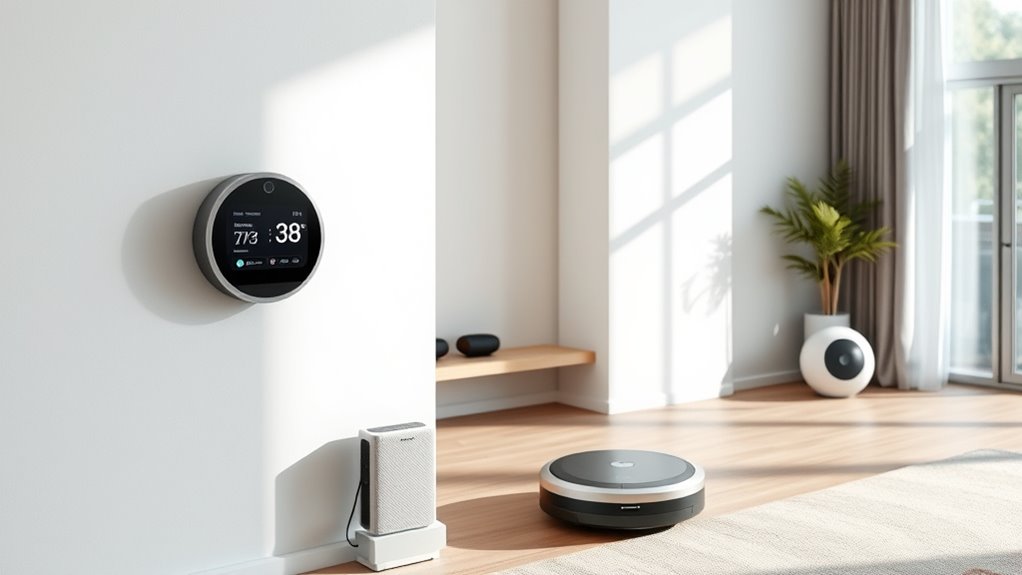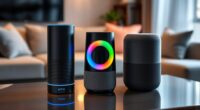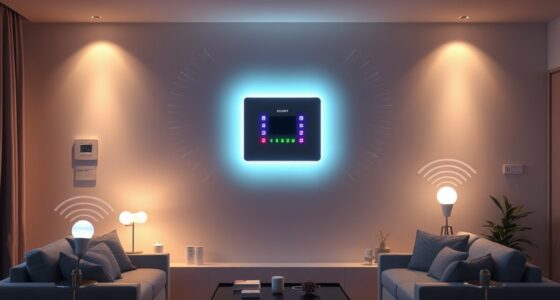To future-proof your smart home and avoid obsolescence, focus on choosing devices that support open standards like Zigbee, Z-Wave, or Thread for seamless integration. Invest in a strong central hub, keep firmware and software updated regularly, and opt for modular hardware that can be upgraded easily. Building a flexible network infrastructure and staying aware of emerging trends will help your system adapt over time. Keep exploring to learn how to build a resilient, scalable setup that stands the test of time.
Key Takeaways
- Choose devices supporting open standards like Zigbee, Z-Wave, or Thread for seamless interoperability and future scalability.
- Invest in a robust, centralized hub that supports firmware updates and diverse device integration.
- Regularly schedule automatic firmware and software updates to ensure security and compatibility.
- Opt for modular hardware systems that allow easy upgrades and component swaps to extend lifespan.
- Build a flexible, mesh network with proper segmentation to support expanding devices securely and reliably.
Choose Devices That Support Open Standards and Protocols
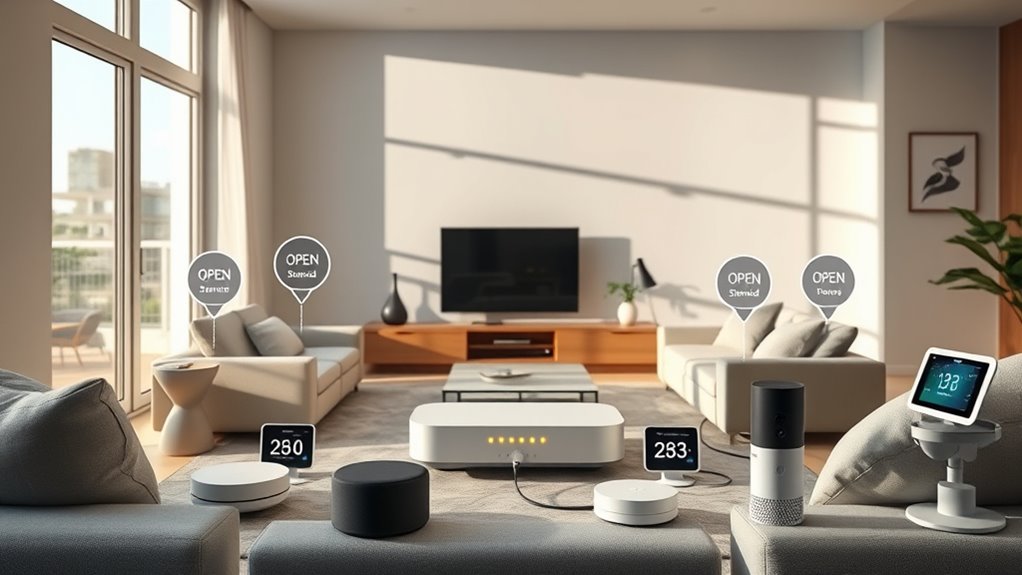
Choosing devices that support open standards and protocols is essential for guaranteeing your smart home remains flexible and future-proof. When selecting gadgets, focus on those compatible with widely adopted wireless standards like Zigbee, Z-Wave, or Thread, which promote seamless device interoperability. Open standards allow your devices to communicate effortlessly, regardless of manufacturer, reducing the risk of obsolescence. This flexibility makes it easier to add new devices later without worrying about compatibility issues. By prioritizing open protocols, you ensure your smart home can evolve with technological advancements and new offerings. Avoid proprietary systems that lock you into specific brands or ecosystems, as they often limit options and complicate expansion. Supporting open standards ultimately guarantees a more adaptable and resilient smart home setup. Additionally, choosing 4K resolution projectors with HDR support can enhance your home entertainment experience, ensuring your devices remain relevant as display technology advances.
Prioritize Compatibility When Expanding Your System

When expanding your smart home system, prioritizing compatibility guarantees that new devices integrate smoothly with your existing setup. Focus on wireless protocols, ensuring they support common standards like Zigbee, Z-Wave, or Wi-Fi, to improve device interoperability. Compatibility reduces the risk of connectivity issues and minimizes the need for additional hubs or adapters. Before purchasing new devices, verify that they work seamlessly with your current ecosystem. This approach helps you avoid obsolescence, as incompatible devices can become obsolete or require costly upgrades. By choosing devices that support your existing wireless protocols, you ensure your smart home remains flexible and scalable, making future expansions easier and more reliable. Compatibility is key to building a cohesive, future-proof smart home. User consent management plays a crucial role in maintaining privacy and data protection as you expand your system.
Invest in a Robust Central Hub or Controller
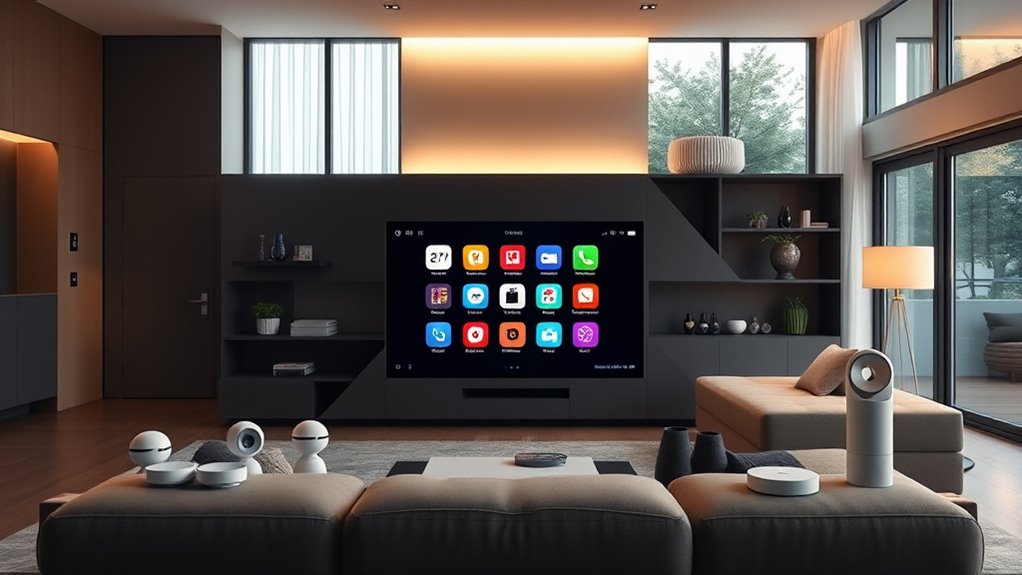
A strong central hub or controller is key to keeping your smart home reliable and flexible. It should support a wide range of devices, handle firmware updates smoothly, and grow with your needs. Choosing the right hub now sets the foundation for a future-proof smart home. Incorporating sustainable technology can also ensure your system remains eco-friendly and adaptable over time.
Compatibility Across Devices
Investing in a robust central hub or controller is essential to guarantee your smart home devices work seamlessly together. A strong hub ensures compatibility across devices, making integration smoother and reducing conflicts. Look for a system that offers voice assistant integration, so you can control everything with simple commands. Cross platform compatibility is equally important; it allows your devices to communicate regardless of brand or protocol. This flexibility protects you from future obsolescence and expands your options for adding new devices later. Additionally, choosing a system with beneficial ingredients like collagen and hyaluronic acid can enhance the overall performance and longevity of your smart home setup. By choosing a versatile hub, you ensure your smart home remains adaptable and functional as technology evolves. Ultimately, a reliable central controller simplifies management and future-proofs your setup against compatibility issues.
Firmware Update Management
To keep your smart home running smoothly, managing firmware updates effectively is essential. Regular updates patch security vulnerabilities that could expose your devices to hacking or data breaches, safeguarding your user privacy. Invest in a robust central hub or controller that handles firmware updates automatically, ensuring your devices stay current without manual intervention. This prevents outdated firmware from becoming a security risk or causing compatibility issues. A reliable hub also centralizes control, making it easier to monitor device status and update history. Additionally, automatic update management can help detect and resolve potential issues before they affect your system’s performance. By prioritizing firmware management, you reduce the chance of vulnerabilities lingering in your system, protecting both your privacy and device longevity. Staying proactive with updates is a key step to future-proofing your smart home against obsolescence and security threats.
Scalability for Growth
Managing firmware updates keeps your smart home secure and running smoothly, but as you add more devices, maintaining control becomes increasingly complex. To ensure seamless user scalability and device interoperability, invest in a robust central hub or controller. This core system handles multiple devices, reduces compatibility issues, and simplifies expansion. A strong hub ensures your smart home can grow without sacrificing performance or reliability. Consider the table below to understand how a central controller supports scalability:
| Feature | Benefit |
|---|---|
| Device interoperability | Seamless communication among diverse devices |
| User scalability | Easy to add and manage new devices effortlessly |
| Centralized control | Simplifies automation and troubleshooting |
| Future-proofing | Accommodates new tech and growing needs |
This investment keeps your smart home adaptable and ready for future upgrades.
Regularly Update Firmware and Software

To keep your smart home secure and running smoothly, you should regularly check for firmware updates and enable automatic updates whenever possible. Scheduling routine firmware checks guarantees you don’t miss critical security patches or new features. Keeping your software current also helps maintain compatibility and performance across all your devices. Additionally, ensuring your devices are compatible with eco-friendly recycled products can promote sustainable practices within your smart home.
Schedule Firmware Checks
Regularly scheduling firmware checks guarantees your smart home devices stay secure and perform at their best. Firmware scheduling involves setting up regular intervals to review and update your device firmware, preventing vulnerabilities and ensuring compatibility with new features. Use update reminders on your devices or apps to stay on top of these checks. By actively managing firmware updates, you avoid the risks associated with outdated software, such as security breaches or malfunctioning devices. This proactive approach helps your smart home run smoothly and keeps your tech future-proof. Remember, staying consistent with firmware checks is essential for maintaining device longevity and maximizing performance. Incorporating this habit into your routine ensures your smart home remains secure, efficient, and up-to-date. Additionally, leveraging data-driven strategies can help you identify which devices require urgent updates and optimize your maintenance schedule.
Enable Automatic Updates
Enabling automatic updates guarantees your smart home devices stay current without you having to manually intervene. With automatic updates, firmware management becomes seamless, ensuring your devices receive the latest security patches and feature enhancements as soon as they’re available. This reduces vulnerabilities and keeps your system compatible with new technologies. Many smart devices have settings to enable automatic updates directly through their apps or web interfaces. By activating this feature, you prevent outdated firmware from causing glitches or security risks. Regular firmware updates also improve device performance and stability, helping your smart home run smoothly over the long term. Additionally, choosing water-resistant devices can further safeguard your system against environmental damage. Don’t delay—set your devices to update automatically so you can enjoy hassle-free, future-proofed technology that adapts with minimal effort.
Keep Software Current
Have you kept your smart home devices up to date lately? Regularly updating firmware and software is crucial for maintaining software security and peak performance. Manufacturers often release updates that patch vulnerabilities, enhance features, and improve the user interface, making your devices easier to navigate and control. Neglecting these updates can leave your system exposed to security risks or cause compatibility issues with new devices or apps. Set your devices to update automatically if possible, or check for updates frequently. Staying current ensures your smart home remains protected, functional, and user-friendly. Remember, software updates aren’t just about new features—they’re essential for preserving the integrity and longevity of your smart home ecosystem. Incorporating personal development practices like mindfulness can also help you stay attentive to your system’s needs and security.
Opt for Modular and Upgradable Hardware
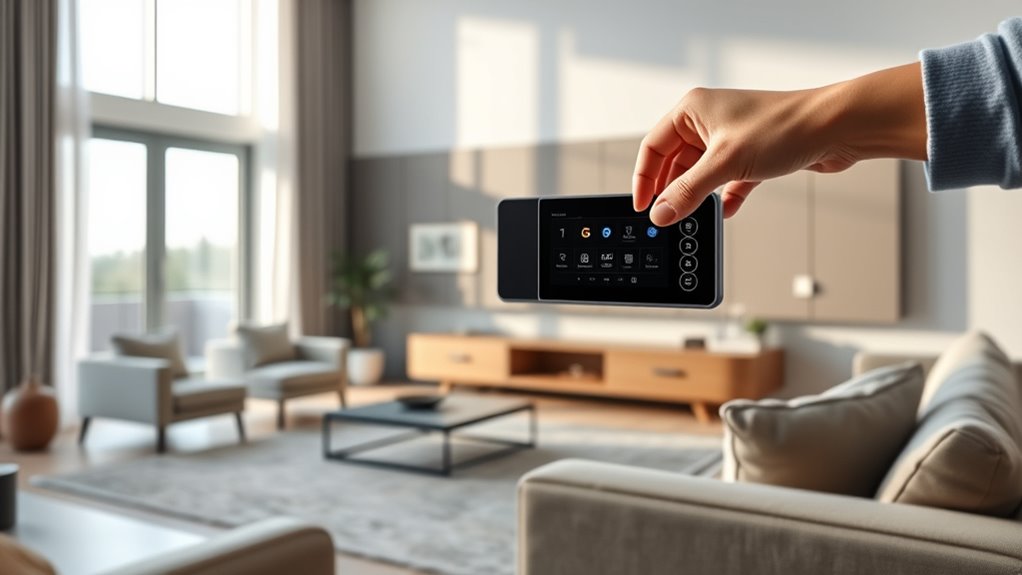
Choosing modular and upgradable hardware guarantees your smart home can adapt to future technologies. Modular hardware allows you to swap out or add components easily, extending the lifespan of your devices. Look for systems with clear upgradeability options so you can enhance features or improve performance without replacing entire setups. This flexibility ensures your smart home stays current as new standards and innovations emerge. Avoid locked-in solutions that limit expansion or updates, which can quickly become obsolete. Prioritize devices that support open standards and have accessible ports or connectors. Additionally, understanding Gold IRA Rollovers can provide insights into diversifying your investment portfolio to ensure long-term financial security. By selecting hardware designed with upgradeability in mind, you future-proof your investment, saving money and avoiding frustration as technology evolves. Staying adaptable now means your smart home remains efficient and relevant for years to come.
Keep an Eye on Industry Trends and Emerging Technologies

Staying informed about industry trends and emerging technologies is essential to future-proof your smart home. By monitoring technology forecasts, you can anticipate innovations that may enhance or replace current devices. This proactive approach helps you avoid obsolescence and stay ahead of the curve. Keep an eye on:
Staying informed on industry trends ensures your smart home remains future-proof and adaptable.
- New standards or protocols that improve compatibility
- Advances in AI and automation capabilities
- Breakthroughs in energy efficiency and sustainability
- Major product launches and industry shifts
Following these trends allows you to make smarter investments and adapt your setup over time. Regularly reviewing trusted sources like industry blogs, tech news, and manufacturer updates ensures you’re aware of the latest developments. Staying informed positions you to integrate future-ready solutions seamlessly.
Build a Flexible Network Infrastructure
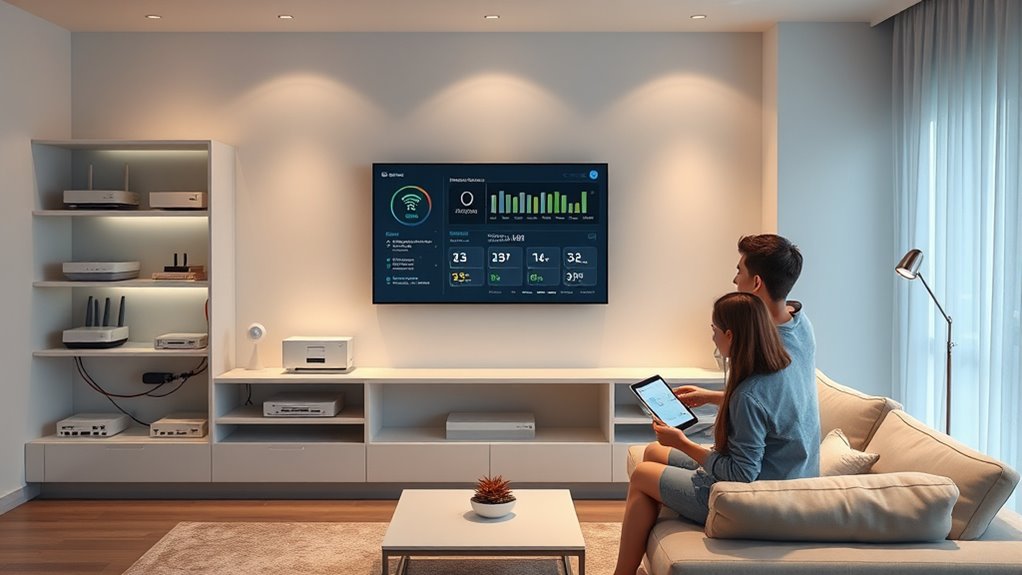
As you keep track of industry trends and emerging technologies, ensuring your network infrastructure can adapt to future upgrades becomes increasingly important. A key step is implementing a wireless mesh system, which provides seamless coverage and easy scalability as your smart home grows. This setup allows devices to connect efficiently without bottlenecks, reducing dead zones. Additionally, incorporating network segmentation helps isolate different device groups, enhancing security and performance. Segmentation ensures that a compromised device won’t affect your entire network and makes managing updates easier. By building a flexible, scalable network that supports wireless mesh and proper segmentation, you future-proof your smart home against obsolescence, making it adaptable to new devices and technologies without costly rewiring or major upgrades.
Establish a Clear Ecosystem Strategy From the Start
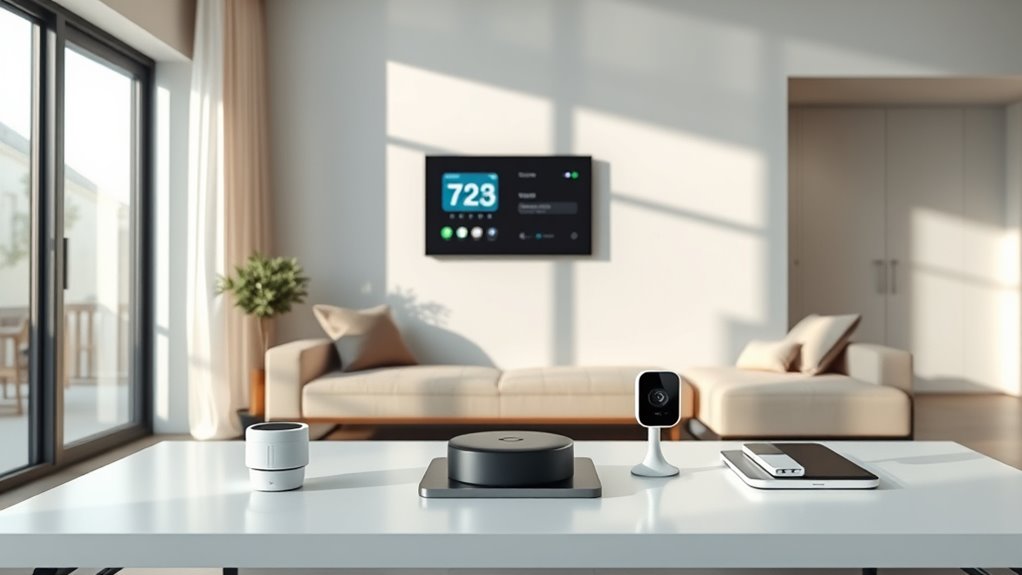
Establishing a clear ecosystem strategy from the start is essential to guarantee your smart home remains manageable and adaptable over time. Proper ecosystem planning guarantees your devices work seamlessly together, reducing frustration and future upgrades. Focus on strategic integration by choosing products that prioritize compatibility and open standards. This approach minimizes obsolescence and simplifies expansion. To get started, consider:
Start with a clear ecosystem plan to ensure seamless, future-proof smart home integration.
- Prioritizing devices with universal compatibility
- Choosing platforms that support multiple brands
- Avoiding proprietary ecosystems that lock you in
- Ensuring future device additions align with your existing setup
Plan for Future Integration and Expansion
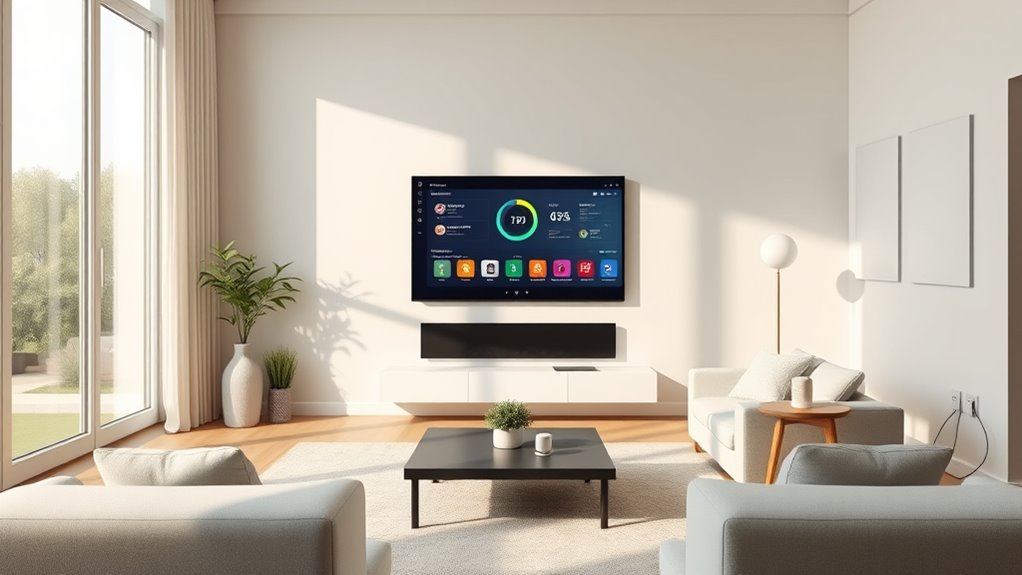
Planning for future integration and expansion guarantees your smart home remains flexible and easy to upgrade. By choosing compatible devices and platforms, you ensure seamless voice assistant integration and smoother energy management. Think ahead about adding new smart features or upgrading existing ones without replacing entire systems.
| Idea | Benefit |
|---|---|
| Use universal hubs | Simplifies adding new devices |
| Prioritize open standards | Ensures compatibility with future tech |
| Modular components | Easier to upgrade individual parts |
| Cloud-based control | Facilitates remote updates and expansion |
| Focus on energy management | Easily incorporate new energy-saving devices |
Frequently Asked Questions
How Can I Ensure My Smart Home Remains Secure Over Time?
You can keep your smart home secure by regularly checking device compatibility and updating firmware. Make certain your devices are compatible with your current network and future upgrades. Enable automatic firmware updates to patch security vulnerabilities promptly. Stay informed about new security features and replace outdated devices. By staying proactive with compatibility checks and firmware updates, you’ll ensure your smart home remains safe and resilient against evolving threats.
What Are the Best Ways to Protect My Data Privacy?
To protect your data privacy, you should always use strong data encryption and regularly update your privacy settings on all devices. Be cautious about sharing personal info and enable two-factor authentication where possible. Keep your software and firmware current to patch vulnerabilities. By actively managing your privacy settings and ensuring data encryption, you reduce risks and maintain control over your smart home’s sensitive information.
How Do I Choose Devices That Won’t Become Outdated Quickly?
When choosing devices, focus on compatibility with popular platforms and standards to guarantee seamless integration. Look for products that offer clear upgrade pathways, so you can update or expand your system without replacing everything. Avoid overly niche devices that may become obsolete quickly. By selecting versatile, well-supported options, you’ll create a smart home that adapts easily as technology evolves, saving you time and money in the long run.
What Should I Consider for Energy Efficiency in Future Upgrades?
Imagine your smart home as a thriving garden, needing the right nutrients to flourish. To boost energy efficiency future upgrades, consider integrating renewable sources like solar or wind, and connect to a smart grid for peak energy use. These choices guarantee your home adapts to evolving technology, reduces costs, and supports sustainability. By planning ahead, you’re cultivating a resilient, eco-friendly haven that grows stronger with each upgrade.
How Can I Make My Smart Home Accessible for All Users?
You can make your smart home accessible for all users by incorporating voice control, allowing everyone to operate devices easily. Embrace universal design principles, ensuring controls are simple and intuitive for people with diverse abilities. You should also consider adjustable interfaces and compatibility with assistive technologies. By doing so, you create an inclusive environment where anyone can enjoy the convenience and benefits of your smart home, now and in the future.
Conclusion
Future-proofing your smart home isn’t just about technology; it’s about peace of mind. Some say that embracing open standards and modular devices guarantees longevity, but history shows tech evolves faster than we expect. By staying adaptable and proactive, you could outsmart obsolescence. Remember, the most resilient systems are built on flexibility. So, invest wisely now—because the true power lies in your ability to adapt and grow with the ever-changing tech landscape.
